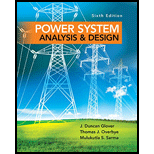
Concept explainers
The following parameters are based on a preliminary line design: per unit
A three-phase power of 700 MW is to be transmitted to a substation located 315 km from the source of power. (a) Determine a nominal voltage level for the three-phase transmission line, based on the practical line-loadability equation. (b) For the voltage level obtained in part (a), determine the theoretical maximum power that can be transferred by the line.
Want to see the full answer?
Check out a sample textbook solution
Chapter 5 Solutions
Power System Analysis and Design (MindTap Course List)
- Calculate the capacitance-to-neutral in F/m and the admittance-to-neutral in S/km for the three-phase line in Problem 4.18. Also calculate the line-charging current in kA/phase if the line is 110 km in length and is operated at 230 kV. Neglect the effect of the earth plane.arrow_forwardIf the per-phase line loss in a 70-km-long transmission line is not to exceed 65 kW while it is delivering 100 A per phase, compute the required conductor diameter if the resistivity of the conductor material is 1.72108-m.arrow_forwardGeometric mean radius of a 3-phase transmission line of 422 kV, 220 km length 22 mm dir. The roughness factor of the conductor is 0.82 and the geometric mean length between phases is 11 m. Air pressure along the line is 720 mm Hg and the temperature is 22 ° C. In this transmission line; a) - Calculate the corona voltage and the voltage at which ionization begins with impingement particles. b) - Find the total corona loss in the three phase system for the operating voltage with the Peek formula c) - Find the total corona loss for 1% increase in operating voltage.arrow_forward
- A 3 phase, 50 Hz, 150 km line has a resistance, inductive reactance and capacitive shunt admittance of 0.1Ω, 0.5Ω, and 3 x 10-6 S per km per phase. If the line delivers 50 MW at 110 kV and 0.8 pf lagging, Using nominal "T" method, determine: a. Sending end current b. Line value of the sending end voltage c. Transmission efficiency d. Voltage regulation e. Sending end power factorarrow_forwardq) lossless transmission line has a capacitance per unit length of 64pF/m and an inductance per unit length of 1μH/m. The load impedance ZL is purely resistive. Both the load impedance and the generator impedance are 50 Ohms.The generator frequency is 12.5MHz. the propagation constant β and wavelength λ equal to? a)π/5 , 10 b)π/5 , 15 c)π/3 , 15 d) π/6 , 8arrow_forwardA 300 km long 3-phase transmission line of 154 kV is operated at 60 Hz. The line is on average 1200 m above sea level and instead At 120m, an air outlet decreases by 10 mmHg. Sea free air the dose is 760 mmHg and the puncture strength of the air is 30 kV / cm As it is known, the roughness of the line is 0.89 for the average outdoor temperature of 34 oC, The distance between the conductors is 550 cm and the conductor cross section is 40mm. along the line by calculating the corona voltage and corona discharge voltage calculate the total corona loss that occurred.arrow_forward
- Design a ‘π’ equivalent circuit for 320 km long 3-φ, 50 Hz transmission line.The line is composed of Drake conductors with the outside diameter of 2.8 cm and flat horizontal spacing of 3.65 m between adjacent conductors. The line has a resistance of 0.075 Ω/km.arrow_forwardA single circuit 60 Hz transmission line. the conductors are Linnet type with flat horizontal spacing of 17.46 feet between conductors. Determine: (a) Assume that the line is short with a length of 50 miles, calculate the parameters of the line and draw the equivalent circuit. (b) Assume that the line is average with length of 150 miles (Pi-nominal model). draw the pi-nominal circuit for the transmission line and calculate its parameters (Z and Y/2 values, where Z is the series impedance of the transmission line and Y is the shunt admittance).arrow_forwardIn a 250 km long, interphase voltage of 154 kV, 50 Hz three-phase transmission line, the diameter of steel core aluminum conductors is 22 mm, the roughness coefficient of the conductors is 0.8, and the spacing between phases is 4 m. Average air temperature along the line is 27 degrees, air pressure is 750 mmHg. Calculate the total corona loss per phase at 1.5 times the operating voltage under these conditions (E0=21.2 kV/cm)arrow_forward
- b) Ghana Grid Company (GRIDCo) designed a short transmission line using the A, B, C, D line constant of a transmission line parameters in its analysis. The engineering planning department came up with the design and said that when they computed the line performance using the equation AD – BC the answer was equal to 1.As an employee at the Ministry of Energy (MoEn) having oversight responsibility over GRIDCo, how would you accept the answer and recommend the Government of Ghana (GoG) to go ahead to implement the short transmission line?arrow_forwardA 50-ohm lossless transmission line has series inductance of 250 nH/m and shunt capacitance of 100 pF/m. What is the time delay per unit length (in ns/m) of this transmission line? Enter only the numerical value. No need for the unit. Use four decimal places (if the answer is not an interger).arrow_forwardA three phase 220KV, 50Hz transmission line supplies a power of 100MW at a power factor of 0.8 lag at the receiving end. The Series resistance, reactance, and shunt susceptance per phase per Km are 0.082, 0.8 2, and 6 x 10-6mho respectively. Determine the efficiency and regulation for transmission line lengths of 60Km and 200Km (use π)arrow_forward
 Power System Analysis and Design (MindTap Course ...Electrical EngineeringISBN:9781305632134Author:J. Duncan Glover, Thomas Overbye, Mulukutla S. SarmaPublisher:Cengage Learning
Power System Analysis and Design (MindTap Course ...Electrical EngineeringISBN:9781305632134Author:J. Duncan Glover, Thomas Overbye, Mulukutla S. SarmaPublisher:Cengage Learning
